15 Types of Jasmine Flowers & Their Gorgeous Color Varieties
Author: Jen Worst | Editor: Omar Alonso
Review & Research: Jen Worst & Chris Miller
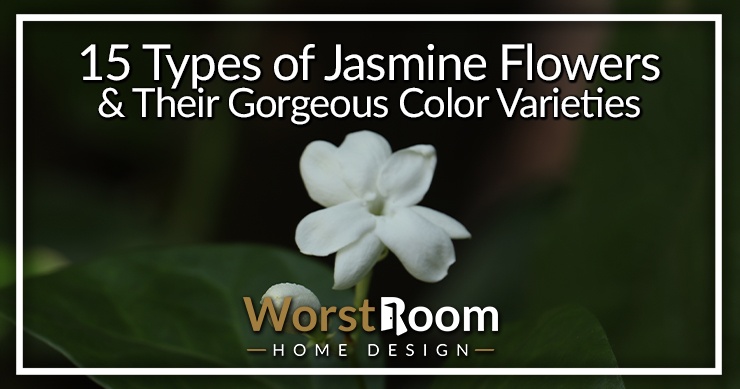
Did you know that there are many different types of jasmine flowers? All of them come from the genus Jasminum, and there are 200 different species under it.
When the topic of best-smelling flowers comes up, jasmine is sure to come up. This stunning flower excels at looking and smelling spectacular.
Usually, when we think of jasmine, we think of the variety Jasminum officinale. But there are various types native to different parts of the world. Today, I will introduce some to ones you can actually get your hands on. Let's begin!
15 Types of Jasmine Flowers
Jasmine varieties vary by color, shape, petal count, and scents. Here are a few common jasmine plant varieties (not including false jasmine flowers, which others include but don't tell you)
Common Jasmine
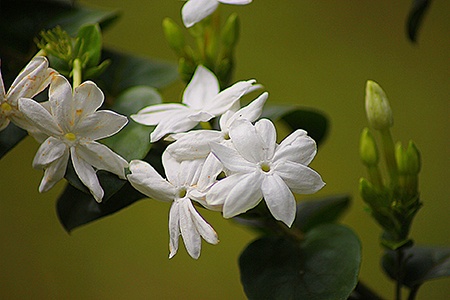
- Scientific Name: Jasminum officinale
- Sunlight Requirement: Full or partial
- Blooming Season: Summer and Fall
- Height: 25 feet
- Color: Pure White
As you can guess from the name Common Jasmine, this is jasmine's most popular and widespread variety. It can be found in any part of the world, and it is a very ancient variety. The white jasmine is the national flower of Pakistan!
It is a vine that is excellent at climbing up any given supports. The flower is white and usually has 5 petals. They grow in clusters. Pair them with climbing vegetables and you'll have a pagoda that's like living in a fantasy.
These varieties of jasmine flowers also produce an intense smell that is sure to charm anyone. The leaves are fuzzy and pointy.
Because it climbs easily and grows fast, this variety is a good choice if you want to cover up space. Don't worry about it spreading everywhere; it is easy to control.
This flower blooms the most during Summer. A mature plant can grow as much as 15 feet.
Dwarf Jasmine
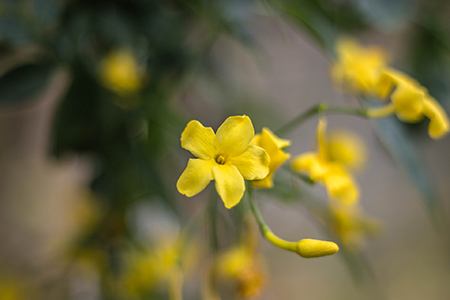
- Scientific Name: Jasminum parkeri
- Sunlight Requirement: Full or partial
- Blooming Season: Summer
- Height: 12 inches
- Color: Yellow
Dwarf types of jasmine flowers boast very bright, yellow blooms that have five petals, round and radiant like the sun. It's evergreen and grows in shrub-like up to a foot in height. It only spreads out by a few feet as well, making it nice and contained.
They're not known for being fragrant or sprawling, but they're grown and used in flower arrangements and types of bouquets due their attractiveness and vivid colors. It's a lush green plant all year around, which also explains its topiary uses.
Angel Wing Jasmine
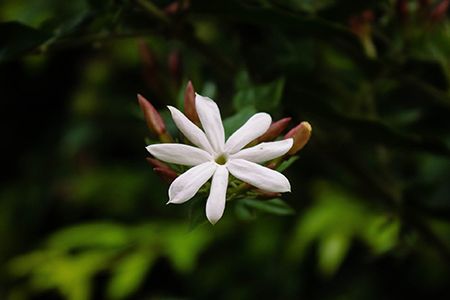
- Scientific Name: Jasminum nitidum
- Sunlight Requirement: Full
- Blooming Season: Summer
- Height: 20 feet
- Color: White with purple
This variety stands out thanks to the unique flowers – they have long, narrow petals. These jasmine flower types are also on the larger side compared to other types of jasmines.
These flowers have a purplish tint to them. Combining the unique shape and color, they are one of the prettiest jasmines.
Much like the flowers, the leaves are well-sculptured and pointy. Like the previous one, this is also a vine plant, and it grows vigorously.
So regular trimming is required if you wish to have them. On the plus side, you can use this plant as a filler between your other shrubs.
This plant is quite versatile. You can use it with support, or hang it from the ceiling, or even plant them as a ground cover.
Pink Jasmine
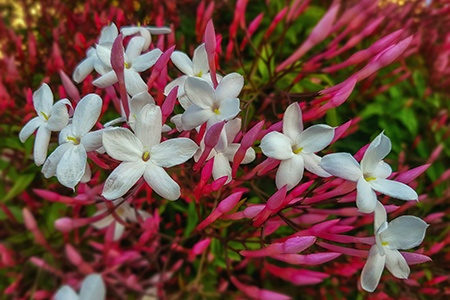
- Scientific Name: Jasminum polyanthum
- Sunlight Requirement: Full or partial
- Blooming Season: Spring and Winter
- Height: 25 feet
- Color: Pink and magenta tones in white
The Pink Jasmine is a native Chinese variety. The flowers from this plant have a pinkish tint to them, hence the name. The buds are a bright magenta, but much of that color will be lost in a full-bloomed flower.
These types of jasmine flowers grow in large clusters, covering the entire plant. This plant is a vine that can grow very high, even higher than 25 feet. So, if you have this, use support such as a trellis or wooden stands to help it out.
The flowers smell intense and rich. If strong scents aren't your cup of tea, don't get these. Visually they can look a bit like types of celosia before blossoming fully.
They don't require much maintenance except for drained soil and regular trimming when in blooming season. They also grow well in a sheltered area. All of these qualities make pink Jasmine a great houseplant.
Royal Jasmine
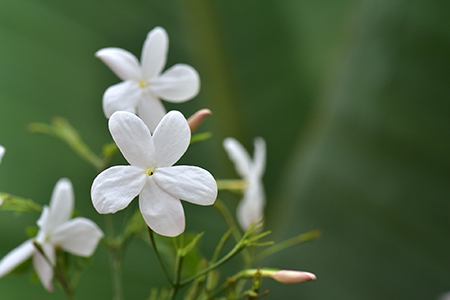
- Scientific Name: Jasminum grandiflorum
- Sunlight Requirement: Full or partial
- Blooming Season: Winter and Fall
- Height: 15 feet
- Color: Pure White
If you prefer flowers with subtle scents, this is the one to get. Royal Jasmines are also known as Spanish Jasmines. Their defining characteristic is that these flowers are the largest among all jasmines.
It is another vine plant with speedy growth. The flowers bloom in clusters, but they produce only a subtle scent. It is the scent you'll typically find in jasmine teas, perfumes, and jasmine flavored items.
While it is a vine, these jasmine plant varieties can also be trained to be a shrub. A mature plant grows up to 15 feet long, which is not very high for vine jasmines.
Unlike other jasmines, their primary blooming season is Fall and Winter. But you'll get blooms during Summer too. These flowers are edible, so feel free to use them on your cakes and desserts for an added elegance. Visually, these really resemble various types of plumbago, especially with the white petals.
Italian Jasmine
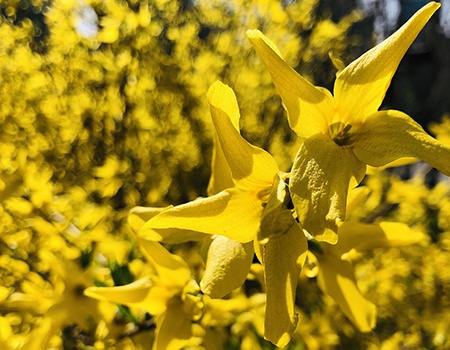
- Scientific Name: Jasminum humile
- Sunlight Requirement: Full or partial
- Blooming Season: Summer and Spring
- Height: 8 – 13 feet
- Color: Yellow
Amongst the shrub jasmines, this is a famous one among gardeners. These plants provide pops of bright yellow flowers on glossy green leaves.
The flowers are drooping and have five petals in total. Because of the droopiness, they look like little bells on the shrub.
These types of jasmine flowers grow in clusters of 6. These flowers bloom beautifully in Summer and Spring. You'll love seeing them fill up your garden and spread the sweet aroma of jasmines.
As it is a semi-vine plant, you can grow it as both a vine and a shrub. The plant attracts bees, so this is a good plant to have if you are into beekeeping.
It is also an excellent choice for beginners, as growing this plant is relatively easy, even in Winters.
Star Jasmine

- Scientific Name: Jasminum multiflorum
- Sunlight Requirement: Full
- Blooming Season: Winter
- Height: 10 feet
- Color: Snow White
Also known as Indian Jasmine flower types, these plants are exquisite. The flowers are unique in the sense that they bloom with 7 petals instead of the usual 5.
Another unusual characteristic is that these flowers don't have a fragrance. They do make up for the lack of scent with rich green leaves and pretty, clustered flowers.
The Star Jasmine is another plant that you can grow as shrubs or give support to have as vines. Because it has no fragrance, it is mainly used as a decorative plant.
Arabian Jasmine
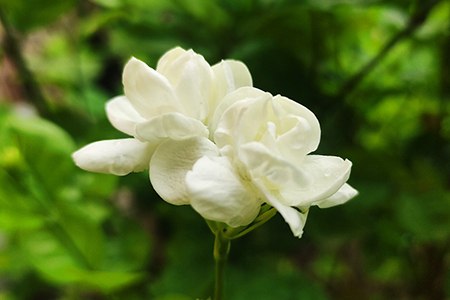
- Scientific Name: Jasminum sambac
- Sunlight Requirement: Full and partial
- Blooming Season: Summer
- Height: Up to 10 feet
- Color: White, gets pink when mature
Ever drank a cup of Jasmine tea? Then you most likely have tasted Arabian Jasmines. This is the national plant of the Philippines. It has that classic jasmine aroma, usually cultivated as a spice.
The flowers of these types of jasmine flowers are small but multilayered. Jasmines generally have only one layer of petals; these stand out from those. These flowers don't bloom in clusters. They are relatively scarce, but the scent is to die for.
The color of these flowers is white, but they often get a pink hue upon maturation. That enhances their beauty even more.
Along with the flowers, the leaves of this plant are also different, with clear veins and oval shapes. Despite having the primary blooming season, Summer, these flowers will make sporadically make your garden smell amazing all year round.
Lemon-Scented Jasmine
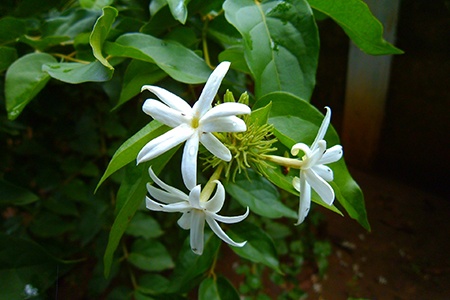
- Scientific Name: Jasminum azoricum
- Sunlight Requirement: Full and partial
- Blooming Season: Summer
- Height: 10 to 12 feet
- Color: White
A prized type of jasmine flowers, enjoyed for their bright white petals and wonderful lemon fragrance. If you want to attract bees and butterflies to help you pollinate, definitely plant these in your types of gardens you have around the home.
Primrose Jasmine
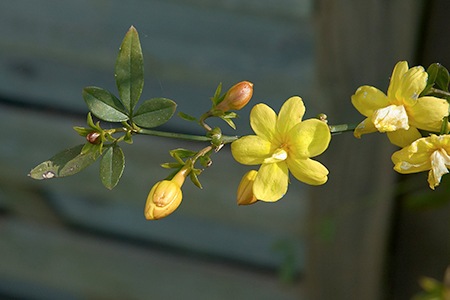
- Scientific Name: Jasminum mesnyl
- Sunlight Requirement: Full or partial
- Blooming Season: Spring
- Height: 6 feet
- Color: Yellow
This is another jasmine variety that has yellow petals. It is a shrub plant that produces small clusters of large jasmine flowers all over its body. These flowers are more prominent compared to regular jasmines.
This plant does well in warm climates. It generally blooms during Spring and does not fare well in the cold. So, if you are situated in colder areas, don't get them. They won't hold up against frost very well.
When it does bloom, it blooms a lot and makes the plant bold and colorful. You'll enjoy seeing so much life in your garden. This shrub is also a speedy climber. So, you can plant it in multiple different settings or even train it into a living fence.
Forest Jasmine
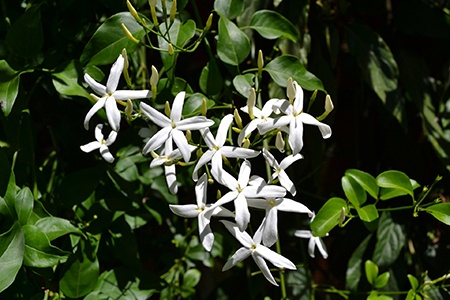
- Scientific Name: Jasminum abyssinicum
- Sunlight Requirement: Full or partial
- Blooming Season: Summer
- Height: 16 to 18 feet
- Color: White
Forest jasmine grows in high altitudes in the tops of mountain wood canopies. These types of jasmine flowers are a climber, sending its tendrils upwards towards the sun where white flowers bloom. These flowers are tinged with pink towards the outer edges and are sweetly scented.
Winter Jasmine
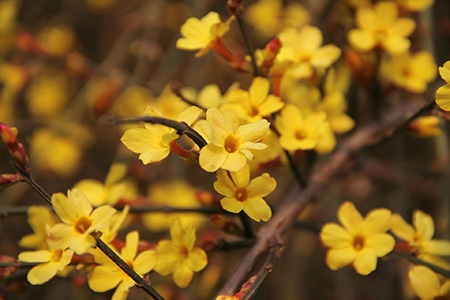
- Scientific Name: Jasminum nudiflorum
- Sunlight Requirement: Full or partial
- Blooming Season: Winter
- Height: 4 to 15 feet
- Color: Yellow
As you have just learned, you cannot plant Primrose Jasmines if you live in a cold climate. But don't be saddened, as this can be a great alternative to have instead! It is another gorgeous yellow variety of jasmine that grows well in Winter.
When everything is cold and bleak, this plant will add a fresh touch of yellow to your balcony or garden. The flowers are on the larger side for jasmine. They are fragrant, too!
You can grow it as a shrub that will grow large and wide (up to 4 feet). But if that is not what you want, then you can also try making it grow like a vine, in which case it can grow up to 15 feet.
Another great quality these flowers have is that the plant provides erosion protection to river banks.
Wild Jasmine
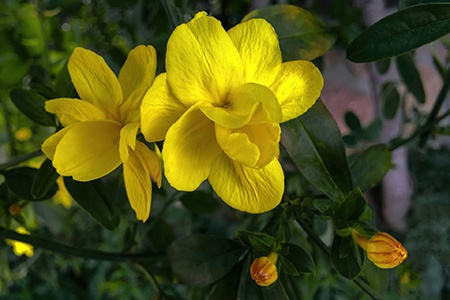
- Scientific Name: Jasminum fruticans
- Sunlight Requirement: Full or partial
- Blooming Season: Spring and Summer
- Height: 12 feet
- Color: Yellow
Are you bored of yellow jasmines yet? I am not, either. Meet Wild Jasmine! This is a low-growing shrub plant that will give you beautiful bright and rich yellow blooms during Summer and Spring. The dark green foliage pops the yellow flowers.
This is a versatile plant that can be used for many applications – in any types of hedges, shrubs, ground covers, hanging plants, and more. These types of jasmine flowers hold their own against harsh weather and chemicals as well. They are fragrance-free; people plant them for the looks.
Downy Jasmine
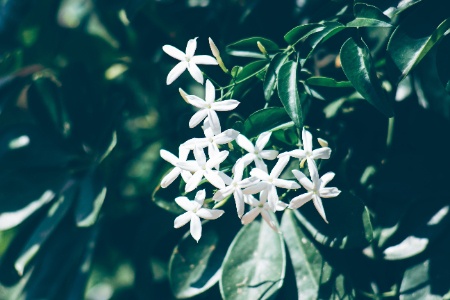
- Scientific Name: Jasminum pubescens
- Sunlight Requirement: Full or partial
- Blooming Season: Spring and Summer
- Height: 8 to 12 feet
- Color: White
What makes these jasmine flower types unique is two-fold. First, they're naturally a vine that wants to climb, but it can be trained to grow as shrub and stay put or even grow along your various types of wire fencing to hide how plain they look.
Secondly, during the right season the entire shrub will be covered in downy flowers, making these jasmine varieties a visual wonder and sight to behold.
Jasminum Vahl
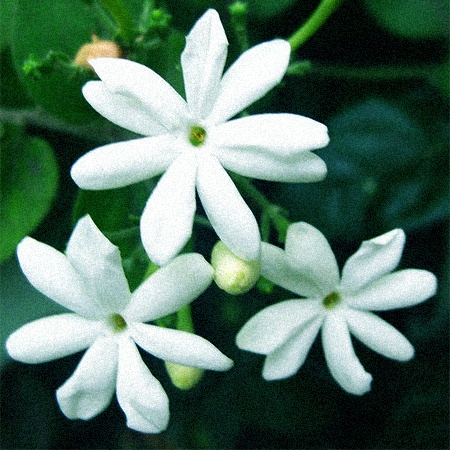
- Scientific Name: Jasminum auriculatum
- Sunlight Requirement: Full or partial
- Blooming Season: Spring and Summer
- Height: 4 to 5 feet
- Color: White
These varieties of jasmine flowers are native to Thailand and India. They're cultivated to harvest their oils and for decoration, of course. The small, white flowers produce an interesting gardenia style of fragrance.
Types of Jasmine Flowers to Breathe Life to Your Flower Bed
As already stated, there are around 200 different varieties of jasmine, so I have highlighted the types of jasmine flowers that are readily available here for you.



